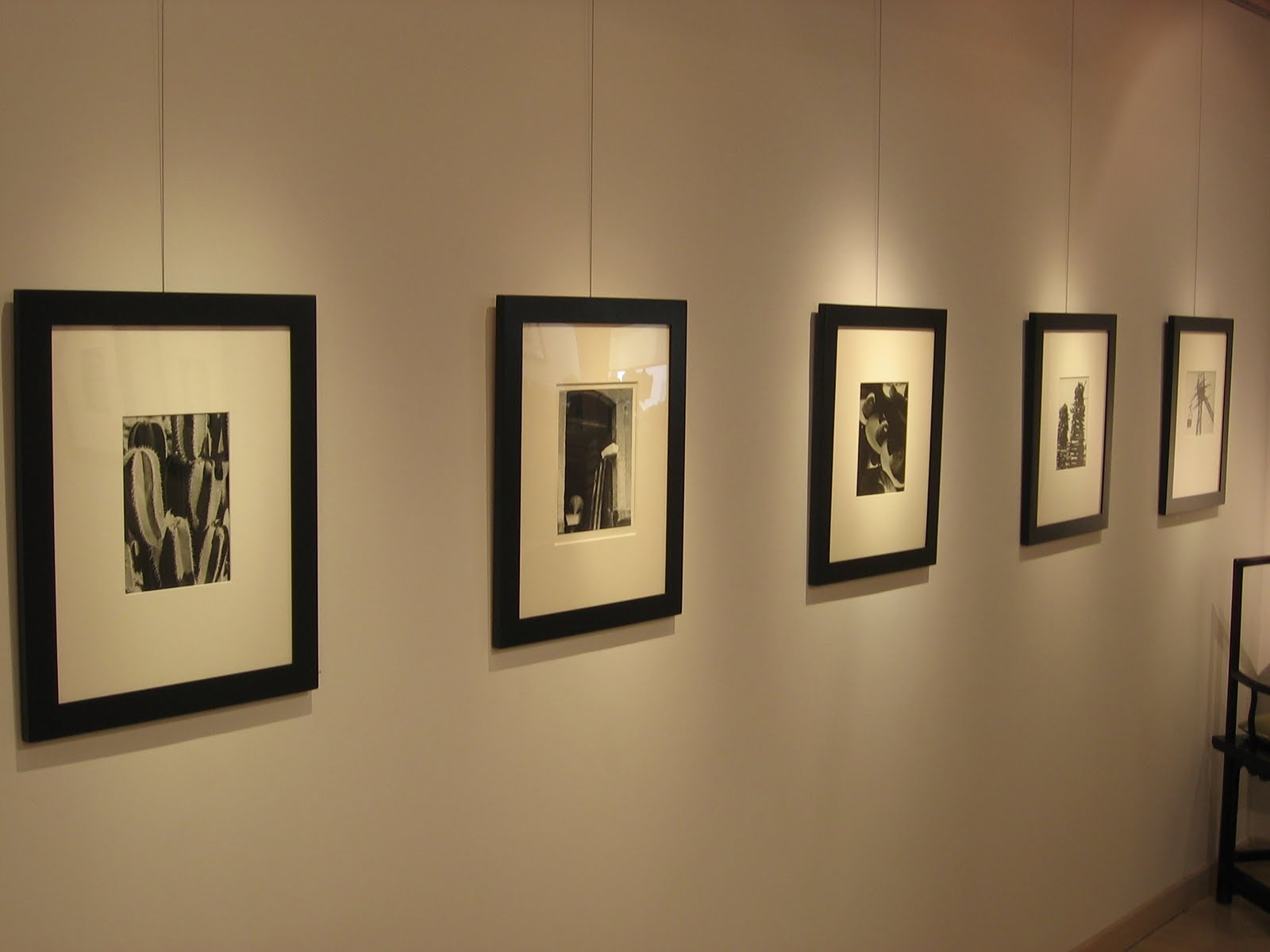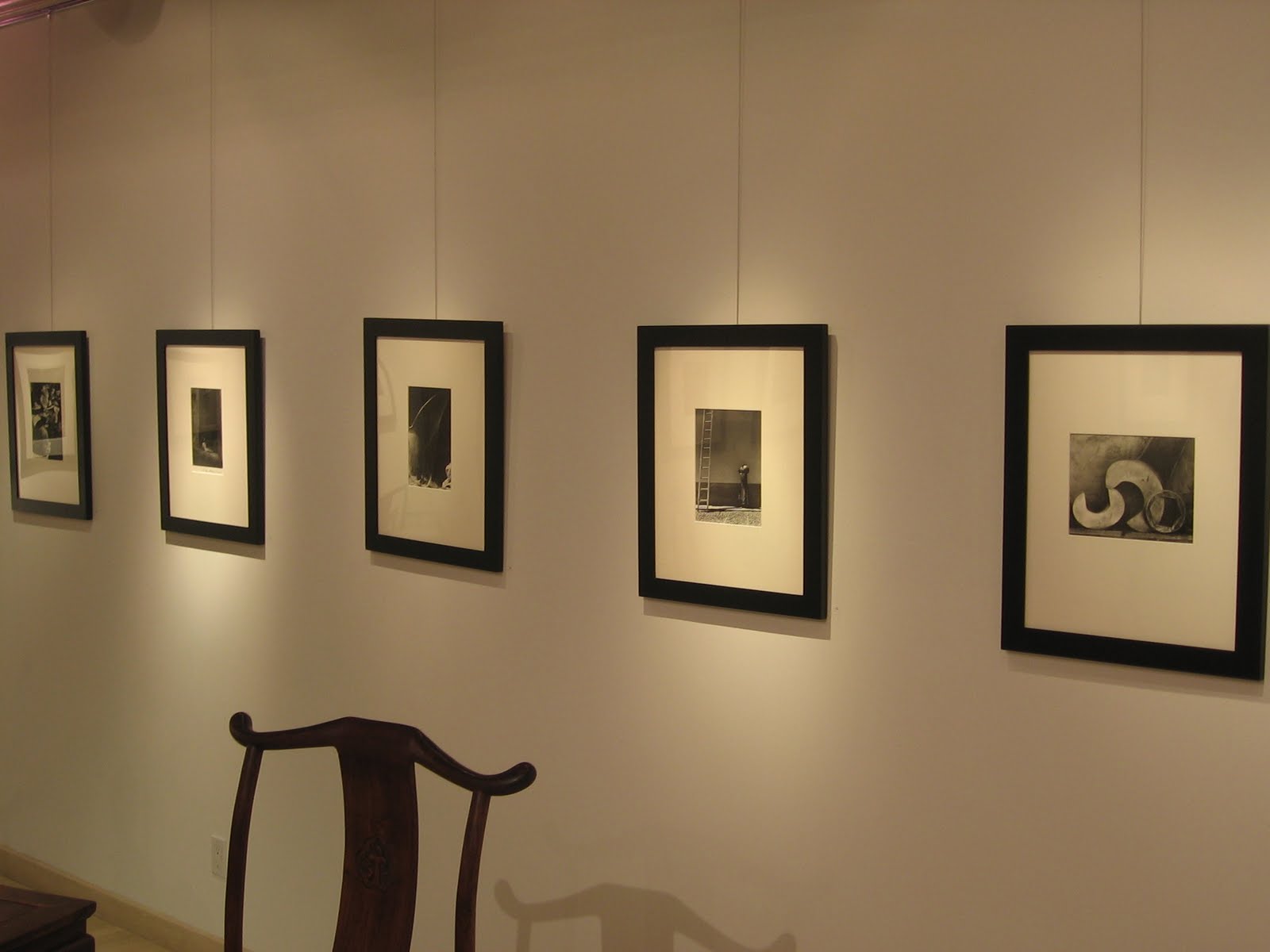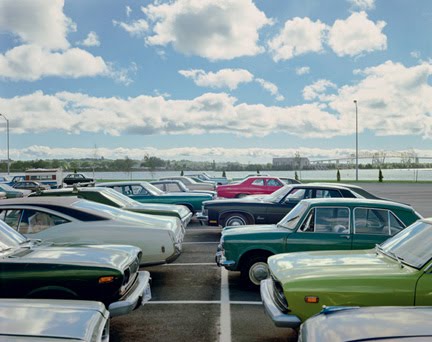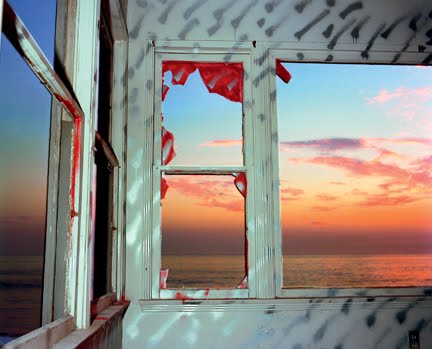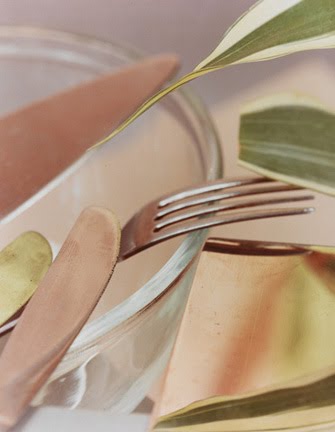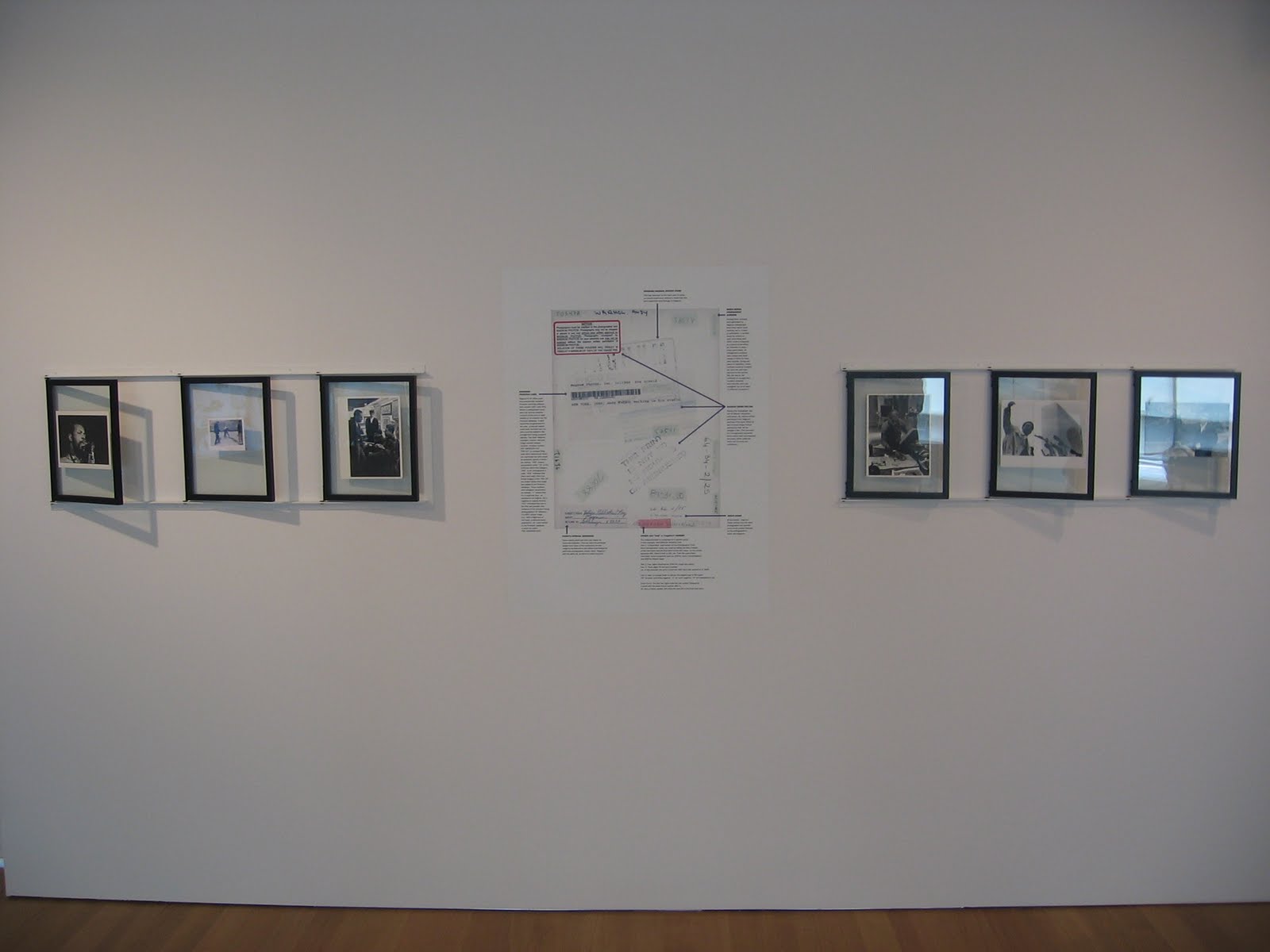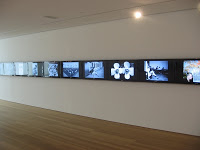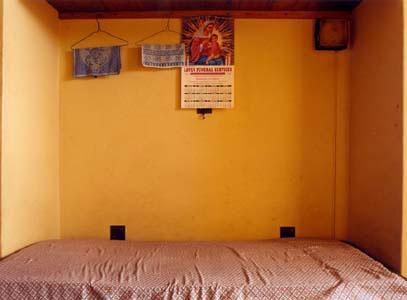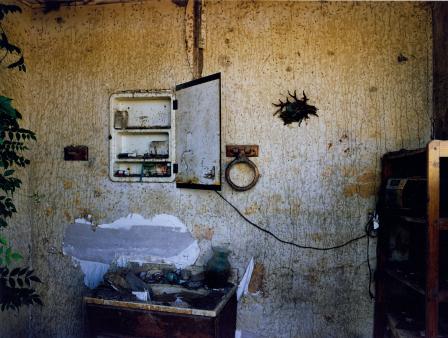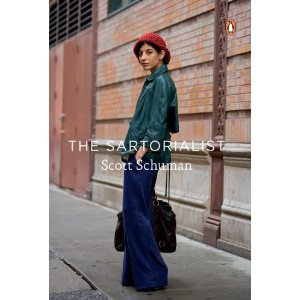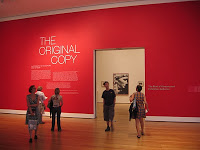 JTF (just the facts): A massive, thematic group show, displayed in a series of 8 connected rooms on the 6th floor of the museum. The exhibit includes 340 works by 110 artists and photographers, covering the period from 1839 to the present. A special exhibition website has been created (here) and a hardback catalog is available in the museum store for $55 (here). The exhibit was curated by Roxana Marcoci. Unfortunately, no photography was allowed inside the exhibit, so there are no installation shots for this show. Aside from the image at right (taken outside the exhibit itself), the single images that accompany this review were taken from the MoMA website.
JTF (just the facts): A massive, thematic group show, displayed in a series of 8 connected rooms on the 6th floor of the museum. The exhibit includes 340 works by 110 artists and photographers, covering the period from 1839 to the present. A special exhibition website has been created (here) and a hardback catalog is available in the museum store for $55 (here). The exhibit was curated by Roxana Marcoci. Unfortunately, no photography was allowed inside the exhibit, so there are no installation shots for this show. Aside from the image at right (taken outside the exhibit itself), the single images that accompany this review were taken from the MoMA website.
The exhibition is divided into ten (10) discrete sections; sometimes a theme fills an entire room, in other cases, an idea takes up an adjacent wall or two. The following photographers have been included in the show, with the number of works on view in parentheses:
I. Sculpture in the Age of Photography
Adolphe Bilordeaux (1)
Brassaï (1)
Jan De Cock (2)
Théodule Devéria (1)
Ken Domon (1 diptych)
Maxine Du Camp (1)
Elliott Erwitt (1)
Roger Fenton (1)
Larry Fink (1)
François-Alphonse Fortier (1)
Ann Hamilton (1)
Alphonse Eugène Hubert (1)
Frances Benjamin Johnston (1)
Clarence Kennedy (6)
André Kertész (4, 1 magazine)
Barbara Kruger (1)
Louise Lawler (1)
An-My Lê (1)
Charles Nègre (2)
Lorraine O’Grady (1 diptych)
Cindy Sherman (1)
William James Stillman (1)
William Henry Fox Talbot (1)
Stephen Thompson (1)
Adam Clark Vroman (1)
II. Eugène Atget: The Marvelous in the Everyday
.
Eugène Atget (29)
 III. Auguste Rodin: The Sculptor and the Photographic Enterprise
III. Auguste Rodin: The Sculptor and the Photographic Enterprise.
Eugène Druet (10) (Eugène Druet, The Clenched Hand, before 1898, at right.)
Edward Steichen (4)
IV. Constantin Brancusi: The Studio as Groupe Mobile
.
Constantin Brancusi (26)
V: Marcel Duchamp: The Readymade as Reproduction
.
Marcel Duchamp (3, 1 case of hand colored photos)
Marcel Duchamp/Man Ray (1)
Man Ray (3)
Henri-Pierre Roché (1)
John Schiff (1)
Alfred Stieglitz (1)
VI. Cultural and Political Icons
.
Berenice Abbott (1)
Ai Weiwei (1)
Sibylle Bergemann (1)
Bruno Braquehais (2)
Henri Cartier-Bresson (6, 2 magazines)
Walker Evans (2)
Robert Frank (1)
Lee Friedlander (20)
Cyprien Gaillard (table of 90 Polaroids)
David Goldblatt (8)
Anselm Kiefer (1)
Josef Koudelka (1)
Nikolai Kuleshov (1)
Alois Löcherer (1)
S.L.A. Marshall (1)
Igor Moukhin (1)
Charles Nègre (1)
Tod Papageorge (1)
Rosalind Solomon (1)
Guy Tillim (2)
Unknown (1)
Garry Winogrand (1)
VII. The Studio Without Walls: Sculpture in the Expanded Field
.
Robert Barry (1 diptych)
Christo (2)
Michael Heizer (1)
Richard Long (1)
Gordon Matta-Clark (1)
Bruce Nauman (1)
Dennis Oppenheim (1)
Robert Smithson (9 as 1, 1 magazine)
Rachel Whiteread (3)
Zhang Dali (1)
 VIII. Daguerre’s Soup: What is Sculpture?
VIII. Daguerre’s Soup: What is Sculpture?.
Brassaï (5, 1 magazine)
Marcel Broodthaers (12 as 1)
Marcel Duchamp (1)
Fischli/Weiss (6) (Fischli/Weiss, The Proud Cook, 1984, at right.)
Robert Gober (3)
Rachel Harrison (41)
Gabriel Orozco (1)
Man Ray (3, 1 magazine)
David Smith (3)
Alina Szapocznikow (6)
IX. The Pygmalion Complex: Animate and Inanimate Figures
.
Johannes Theodor Baargeld (2)
Herbert Bayer (1)
Hans Bellmer (2, 1 magazine)
Claude Cahun (1)
Henri Cartier-Bresson (1)
Max Ernst (2)
Walker Evans (1)
Hans Finsler (1)
Laura Gilpin (1)
Hannah Höch (1)
Horst P. Horst (1)
André Kertész (3)
Clarence John Laughlin (1)
Robert Mapplethorpe (1, 6 as 1)
Man Ray (4, 2 magazines)
Jindřich Štyrský (1)
Maurice Tabard (1)
Sophie Taeuber–Arp (1)
Gillian Wearing (1)
Edward Weston (1)
Iwao Yamawaki (1)
X. The Performing Body as Sculptural Object
.
Bas Jan Ader (4 as 1)
Eleanor Antin (32 as 1)
Joseph Beuys (1)
Günter Brus (1)
Jim Dine (1)
Marcel Duchamp (1)
VALIE EXPORT (1)
Gilbert & George (1)
Red Grooms (1)
Yves Klein (1, 1 newspaper)
Milan Knížák (1)
Yayoi Kusama (1)
Ana Mendieta (2)
Robert Morris (1)
Bruce Nauman (4)
Claes Oldenburg (2)
Dennis Oppenheim (1)
Charles Ray (2)
Robin Rhode (9 as 1)
Hannah Wilke (10 as 1)
Robert Whitman (2)
Erwin Wurm (9 as 1)
Comments/Context: One of the now agreed upon truths of the digital age is that photography no longer belongs in its own separate artistic silo, isolated from the rest of contemporary artistic practice – there are just too many artists routinely drawing on photographic tools and techniques to keep the medium segregated in its own misunderstood backwater. With the convergence of media, art historians, scholars and artists are now exploring connections between heretofore largely separate lines of thinking and discovering new ways to see relationships between works of art that had traditionally been kept far apart.
Roxana Marcoci’s smart show on the intersections of photography and sculpture digs into a seemingly obvious theme (artists making pictures of sculpture) and unearths a rich vein of interaction and cross pollination, going all the way back to the invention of photography. It seems these two art forms have been having a complicated, evolving conversation for many decades now, but perhaps we just weren’t paying close enough attention to see how the many ideas were flowing back and forth. This exhibit attempts to set the record straight, to follow the connections back to their sources, and to provide a conceptual construct to tease out the underlying influences and important conclusions. While such a task is inherently messy, this show does a generally fine job of giving us new ways to understand the powerful links between these two artistic mediums.
The exhibit gets off to a stumbling start with an introductory room that tries to be too clever. In what should have been a tightly edited group of 19th century works used to set the foundation for how photography and sculpture began their relationship, we instead get a puzzling juxtaposition of 19th century and contemporary works that fails to clarify the thesis to be explored. To my eye, and with the benefit of knowing what comes later in the show, the contemporary works which are interleaved with the 19th century images are those that don’t easily match any of the later themes; they are a gathering of one-offs that didn’t fit more naturally somewhere else, but were relevant or exciting enough to want to be jammed in. But put these distractions aside for a moment and focus on the 19th century works in this first room. While you might expect that the earliest photographs of sculpture would be straightforward documents, think again. From the very beginning, photographers used effects of light, scale, and composition to subtly alter the way we experience marble statues and stone busts; some grouped collections of antiquities into dense still lifes, others found drama in broken fragments or narrative in studio views.
.
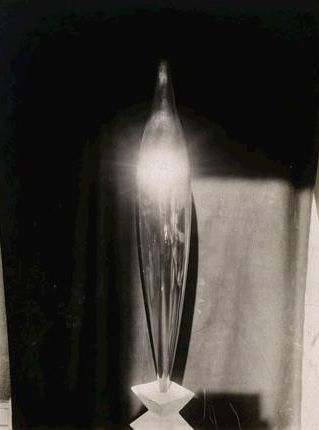
This idea of photography being used to interpret sculpture is explored expertly in the next three sections of the show. Three different sets of images by
Eugène Atget show how he applied his own viewpoint in capturing the sculpture found at Versailles, Saint Cloud,
Sceaux and elsewhere. He looks up at statues and frames them against dark backgrounds to create drama, he peers across formal ponds and gardens at silhouettes of tiny statues (
disregarding the rigid symmetry of the architects), and he gets up close to highlight fragments of ornate door knockers and reliefs on urns. Rodin’s
sculptures are interpreted in the next section, with
Steichen bathing Balzac in green
Pictorialist moonlight, and
Druet narrowing in on gnarled, expressive hands and
experimenting with time via making photographs of sculptures in various stages of completion. Perhaps the best example of
interpretation comes in the section of photographs Constantin
Brancusi made of his own sculpture.
Brancusi clearly understood the different aesthetic options provided by photography. His images experiment with glare, reflection and blurring, and his studio is a cluttered
installation of ever shifting
permutations of sculpture, bases, and pedestals. All of these techniques are used in the attempt to see the sculpture in new ways, to capture alternate realities not evident in their three dimensional forms. I found these pictures to be
astonishingly interesting and multi-layered, in a way that I had failed to notice before. (Constantin
Brancusi,
Golden Bird, c1919, at right.)
Marcel Duchamp provides the next big conceptual breakthroughs, with his readymade sculptures and assemblages of random objects. While the photographs on display in the Duchamp section aren’t particularly inspiring, the ideas of making sculpture out of found objects, or of creating impermanent installations of things that then function as sculpture were groundbreaking. Suddenly, a photograph of almost anyhting could be a sculpture, and fleeting events, performances and happenings could be documented by the camera and preserved as a kind of ephemeral sculpture. These fundamental ideas would provide fodder for artists for the next few decades, and are elaborated on in several additional sections of the exhibit.
.
One nearby room is devoted to a wide variety of photographic documents of altered sites, land art, and outdoor events: Dennis Oppenheim’s rings in the snow, Gordon Matta-Clark’s cut up house, and Christo’s barrels stacked up in front of the MoMA. In each case, sculpture was created to be photographed; photography was both an integral part of the conception of the project and a necessary enabler. The two mediums (photography and sculpture) were now completely intertwined, their combination allowing for new forms of artistic expression. Another room follows Duchamp’s readymade concept to its ultimate end, where found objects of all kinds are isolated and turned into sculptural forms. Man Ray’s hand mixer, Brassaï’s cotton balls, toothpaste, and bus tickets, and Alina Szapocznikow’s chewing gum all become something exciting when their context is changed by the camera. (It seems to me that this theme could also have included a Blossfeldt flower or a Weston pepper, as “objectivity” was prized by both German and American photographers in the 1920s/1930s and their collective works set the stage for many who came later.) In all of these images, the photographer is not only discovering the sculpture, but then interpreting it as well; without the photograph, the object would have no life as a “sculpture”.
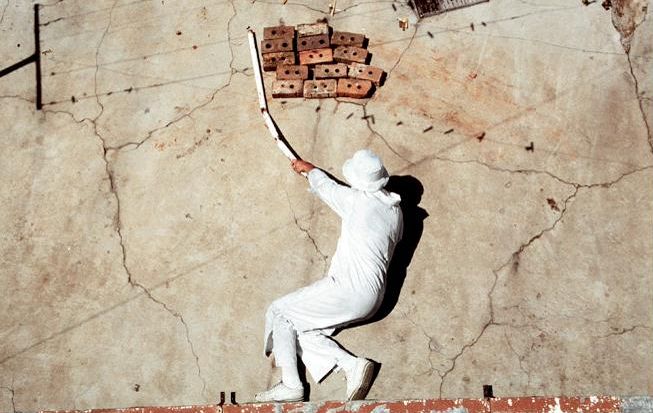 The final room of the exhibit opens up the idea of the artist’s body as living sculpture, and of the camera being a witness to performance art of various kinds. While many collectors will be more familiar with the works on display here, as they fit more neatly into the conceptual ruts of contemporary art, many seem to take on a freshness when seen from the vantage point of photography as the willing participant in the artistic process. Erwin Wurm’s one minute sculptures (pickles between toes, a chair resting on a woman’s eye), Ana Medieta’s body covered with mud or flowers, Bruce Nauman’s visual puns and Robin Rhode’s trompe l’oeil flag waving all rely on photography to help create the illusions and unexpected situations. (Robin Rhode, Stone Flag (detail), 2004, at right.)
The final room of the exhibit opens up the idea of the artist’s body as living sculpture, and of the camera being a witness to performance art of various kinds. While many collectors will be more familiar with the works on display here, as they fit more neatly into the conceptual ruts of contemporary art, many seem to take on a freshness when seen from the vantage point of photography as the willing participant in the artistic process. Erwin Wurm’s one minute sculptures (pickles between toes, a chair resting on a woman’s eye), Ana Medieta’s body covered with mud or flowers, Bruce Nauman’s visual puns and Robin Rhode’s trompe l’oeil flag waving all rely on photography to help create the illusions and unexpected situations. (Robin Rhode, Stone Flag (detail), 2004, at right.)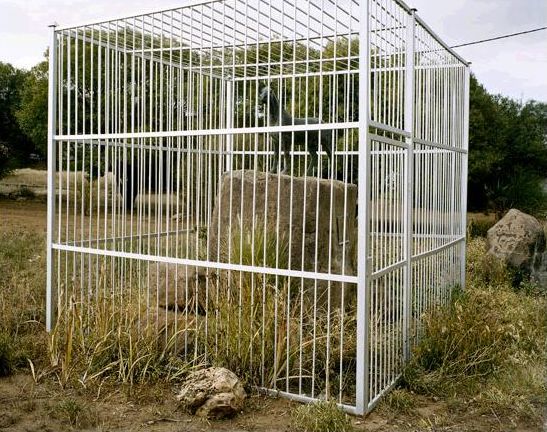 The other two sections in the show seem like tangential but relevant bolt-ons to the main line of reasoning. One centers on a specific type of sculpture, the public monument, and chronicles how artists have evolved their approaches to photographing it. The mini-thesis here is that from the very beginning photographers have been commenting on monuments via their images. The section starts with a few 19th century images, but quickly transitions to 20th century works that apply increasing levels of irreverence and irony, providing alternate contexts for what were supposed to be heroic or ideal symbols. Igor Mouhkin finds a Russian worker statue in an overgrown alley, Robert Frank silhouettes St. Francis in front of a gas station, Henri Cartier-Bresson captures tourists pulling on Abraham Lincoln’s nose, and a series of Lee Friedlanders juxtapose monuments and memorials with beer cars, a lost dog sign, and the chaos of Times Square. David Goldblatt and Guy Tillim provide a more caustic edge, with Nelson Mandela dwarfed by construction scaffolding, and Henry Stanley toppled over and broken off at the feet. In the end, Ai Weiwei gives San Marco square in Venice the finger. (David Goldblatt, Monument Honouring the Contribution of the Horse to South African History, 2005, at right.) The other section loosely connected to the main line of thinking covers a grab bag of mannequins, dolls, figurines and puppets, mixed together with collage and photomontage effects. These pictures draw on themes from other sections: found objects as sculpture, the staging of imagery just for the camera, and the mixing of photography and sculpture to create alternate artistic options.
The other two sections in the show seem like tangential but relevant bolt-ons to the main line of reasoning. One centers on a specific type of sculpture, the public monument, and chronicles how artists have evolved their approaches to photographing it. The mini-thesis here is that from the very beginning photographers have been commenting on monuments via their images. The section starts with a few 19th century images, but quickly transitions to 20th century works that apply increasing levels of irreverence and irony, providing alternate contexts for what were supposed to be heroic or ideal symbols. Igor Mouhkin finds a Russian worker statue in an overgrown alley, Robert Frank silhouettes St. Francis in front of a gas station, Henri Cartier-Bresson captures tourists pulling on Abraham Lincoln’s nose, and a series of Lee Friedlanders juxtapose monuments and memorials with beer cars, a lost dog sign, and the chaos of Times Square. David Goldblatt and Guy Tillim provide a more caustic edge, with Nelson Mandela dwarfed by construction scaffolding, and Henry Stanley toppled over and broken off at the feet. In the end, Ai Weiwei gives San Marco square in Venice the finger. (David Goldblatt, Monument Honouring the Contribution of the Horse to South African History, 2005, at right.) The other section loosely connected to the main line of thinking covers a grab bag of mannequins, dolls, figurines and puppets, mixed together with collage and photomontage effects. These pictures draw on themes from other sections: found objects as sculpture, the staging of imagery just for the camera, and the mixing of photography and sculpture to create alternate artistic options.
.
The show ends on a rather abrupt note, and left me wondering why a bridge to the future was left unbuilt. Where are the mixed media digital mashups, the computer generated forms, and the algortihms or executables as sculpture? A final small room of wild, unruly hybrids and flights of fresh fancy would have made the case that the disciplines of photography and sculpture will be inextricably intermingled on a going forward basis, evolving in directions we haven’t yet begun to understand.Overall, I found Marcoci’s conceptual argument well-reasoned and thoughtful, with illuminating examples to be found in nearly every section. While I might quibble with a few of the choices here or there, in general, this exhibit successfully delivers a new perspective on the role of photography in the larger artistic discussion and convincingly proves that sculpture and photography have had a long history of co-dependence. It’s a challenging, intellectual approach that expects some active engagement by the viewer and rewards this time spent with some simple, but powerful ideas. So in the dog days of summer, go and engage your brain, and whatever you do, don’t miss the Brancusis.
.
Collector’s POV: This kind of a broad museum survey, heavy on scholarly argument, isn’t a great place for a discussion of gallery/auction prices or market dynamics. So we’ve highlighted a few favorites, but dispensed with the usual discussion of pricing trends.Rating: *** (three stars) EXCELLENT (rating system described here)
Transit Hub:
- Reviews: NY Times (here), Wall Street Journal (here), L Magazine (here), Village Voice (here)
Through November 1st
 JTF (just the facts): A total of 30 black and white photographs, pinned directly to the wall under glass, and hung in the simple single room gallery space. All of the works are vintage gelatin silver prints, made in editions of 8 between 1953 and 1983. Most of the prints are sized at 12×16 or reverse, with a few at 12×12, and one at 7×16. A monograph of this body of work, entitled Karambolage, was published by Steidl in 2003 (here).
JTF (just the facts): A total of 30 black and white photographs, pinned directly to the wall under glass, and hung in the simple single room gallery space. All of the works are vintage gelatin silver prints, made in editions of 8 between 1953 and 1983. Most of the prints are sized at 12×16 or reverse, with a few at 12×12, and one at 7×16. A monograph of this body of work, entitled Karambolage, was published by Steidl in 2003 (here). Collector’s POV: The vintage prints available in this show are priced between $3200 and $4500. Odermatt’s work has not been widely available in the secondary markets, although a handful of prints have come up for auction in the past few years; prices for these lots have ranged between $2000 and $4000.
Collector’s POV: The vintage prints available in this show are priced between $3200 and $4500. Odermatt’s work has not been widely available in the secondary markets, although a handful of prints have come up for auction in the past few years; prices for these lots have ranged between $2000 and $4000.